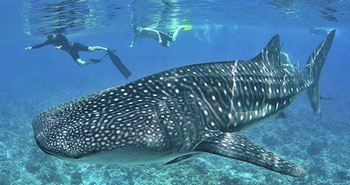Baa Atoll was designated as a UNESCO World Biosphere Reserve in 2011. From a marine life perspective, manta ray aggregations at Hanifaru Bay are Baa's the most famous feature, but there globally significant reefs here too and a total of 11,000 people live on 13 of its 75 islands. Regular pelagic visitors include turtles, dolphins and whale sharks.

Hanifaru Bay (Vandhumaafaru Adi)
Hanifaru Bay is the venue of one of the most reliable large gatherings of manta rays in the world, with up to 100 individuals in the small inlet. This is the reef manta species (Manta alfredi) which famously can often be found feeding in neat lines, one manta behind the other. Barrel rolling can also sometimes be observed.
Whale sharks (Rhincodon typus) are also often seen here, which like the manta rays are attracted by plankton brought into the bay by south west monsoon upwellings between May and November. As we find in much of the Indian Ocean, the whale sharks here are usually adolescent males.
Diving is not permitted in Hanifaru, but encounters here by snorkel make this something open to almost anyone. Necessarily, this activity has become carefully managed, with full time rangers and restricted access to key sites within two Marine Protected Areas. The Manta Trust has been researching manta rays in the area for many years and was instrumental in establishing a conservation management plan for the site.
There are other locations on Baa Atoll where manta rays can be observed, so with increasing visitor numbers to the bay this is sometimes the preferred option on liveaboard visits.
Dhonfanu Thila
With its interesting topography, abundant marine life and regular manta ray appearances, this pinnacle effectively showcases the best that Baa Atoll has to offer. A stunning amount of fish can be found here including red-toothed triggers, black pyramid butterflyfish, parrotfish, angelfish, longnosed butterfly fish, unicornfish and starry rabbitfish to name but a few.
The overhangs provide shelter for large numbers of yellow-lined snapper and soldier fish, whilst a continuous series of cascading moon fusiliers and broad-striped fusiliers spill around the edges of the reef and cleaning wrasses ply their trade. Larger visitors here include grey reef sharks, barracuda and large schools of jacks.
Dharavandhoo Thila
This beautiful coral formation is situated on the south side of Dharavandhoo Island. The top of the reef is found at 5 metres, with a sandy slope to one side which can sometime provide good opportunities for manta rays. On the other side, a steep wall with large coral blocks and stunning overhangs connect the thila to the main island reef. This steep coral wall is home to sponges, sea fans, whips and black coral bushes which provide shelter for a variety of fish and is excellent for photography.
Voavah Thila
This tiny reef offers an amazing display of colourful soft, fan and pink corals along with extensive varieties of gobies. Anemone-like structures can be found in abundance on the reef along with butterflyfish, red bass and blue-lined snappers, while white spotted razor fish can often be seen on the sandy sea floor.
Maavaru Kandu
This stunningly colourful reef is characterized by pendulous soft corals and vibrant marine life. The downward facing overhangs are bedecked in a rainbow of soft corals, colouring the reef in shades of blue, green and yellow with whip corals, brick red sponges, black bush corals and zoanthids. As the reef flattens out you will find a range of fans, table, stony and mushroom corals. The reef is home to a range of reef fish including midnight snapper, small-toothed emperor, coral rock cod, moon fusiliers and broad-striped fusiliers, whilst the shallows play host to hundreds of tiny orange basslets, moon wrasse and lizardfish.
Dhigali Haa
This submerged pinnacle comes within around 7 metres of the surface and has a couple of smaller neighbouring pinnacles to explore. Big-nosed unicorn fish sometimes seem to enjoy playing in the chimneys of bubbles created by divers and will come to you as you descend down the reef. The top of the pinnacle is home to numerous anthias, basslets and dottybacks while legions of blue-dash fusiliers, jacks and trevallies might be seen hunting small baitfish that swarm in huge numbers just off the reef. The quieter areas of the reef often play host to yellow-lined snapper, small fans and scribbled filefish.
This site is excellent for photographers with spiral whip corals and anemones playing host to pairs of porcelain crabs. Here you can also find the Maldivian sponge snail, an unremarkable looking snail endemic to the Maldives which moves around one centimetre per day.
Source: Aqua-Firma







0 comments:
Post a Comment